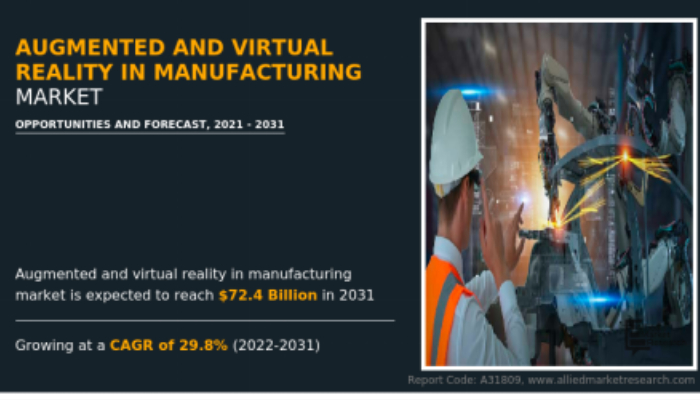Increasing investments and cost-effective AR/VR solutions in manufacturing are driving growth in the global AR/VR manufacturing market.
According to the report, the global augmented and virtual reality in manufacturing market size generated $5.4 billion in 2021, and is anticipated to generate $72.4 billion by 2031, witnessing a CAGR of 29.8% from 2022 to 2031.
VR and AR are the technologies that are transforming the ways in which users use screens and producing innovative and engaging interactive experiences. Additionally, with virtual reality, users can explore a world created by a computer by wearing a headset and other wearable devices. On the other hand, augmented reality is somewhat different. By using a smartphone or clear eyewear, it layers digital visuals onto the environment around people rather than taking them to a virtual world.
AR and VR) in manufacturing refers to the use of immersive technologies to enhance various stages of the manufacturing process, from design and prototyping to training, quality control, and maintenance. AR overlays digital information onto the physical world, allowing workers to visualize instructions, measurements, and processes directly on the equipment or products they are working on, while VR creates fully immersive, simulated environments for tasks like design visualization, worker training, or virtual assembly line testing. Together, these technologies improve efficiency, reduce errors, enhance training, and support better decision-making in manufacturing.
Rise in investments in AR and VR in manufacturing and the cost-efficient benefits of augmented and virtual reality-based solutions in manufacturing drive the growth of the global augmented and virtual reality in manufacturing market. However, the high investment required in setting up AR and VR in manufacturing market and concerns regarding security and privacy issues associated with AR restrict the market growth. Moreover, the rise in digitalization in the manufacturing industry is anticipated to provide numerous opportunities for market growth in the coming years.
For Report Customization: https://www.alliedmarketresearch.com/request-for-customization/A31809
Based on age group, the large enterprises segment accounted for the largest share in 2021, contributing to more than three-fifths of the global augmented and virtual reality in manufacturing market, and is projected to maintain its lead position during the forecast period, owing to the growing adoption of AR and VR for machine-to-machine communication or other systems based on data exchange between machines and components is driving the market in large enterprises. However, the small and medium-sized enterprises segment is expected to portray the largest CAGR of 31.1% from 2022 to 2031, owing to the growing awareness of their benefits among end users.
Based on technology, the augmented reality segment held the highest market share in 2021, accounting for nearly three-fifths of the global augmented and virtual reality in manufacturing market, and is estimated to maintain its leadership status throughout the forecast period, as technology development in AR provides a product configurator that is used to bridge the gap between product design and sale. On the other hand, the virtual reality segment is projected to manifest the highest CAGR of 31.0% from 2022 to 2031, as it helps in decision-making regarding the expansion and advancement of land, buildings, and machinery.
Based on components, the hardware segment held the highest market share in 2021, accounting for more than two-fifths of the global augmented and virtual reality in manufacturing market, and is estimated to maintain its leadership status throughout the forecast period, owing to the surge in the utilization of the Internet of Things (IoT) platform allows the programming language for all SaaS technologies hosted in the cloud. However, the services segment is projected to manifest the highest CAGR of 31.3% from 2022 to 2031, owing to the growing integration of the developing technologies of computer graphics, computer simulation, artificial intelligence, sensing, display, and network parallel to processing technologies in manufacturing is enhancing the services for manufacturing sectors.
Based on region, North America held the highest market share in terms of revenue in 2021, accounting for nearly two-fifths of the global augmented and virtual reality in manufacturing market, and is likely to dominate the market during the forecast period, owing to its potential to reduce accidents and disruptions in manufacturing units with the various aids offered by solution providers. However, the Asia-Pacific region is expected to witness the fastest CAGR of 31.4% from 2022 to 2031, owing to supportive government initiatives in the manufacturing sector, an increase in adoption, and advancement in internet connectivity.


